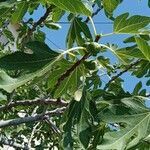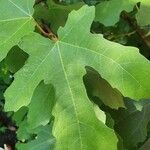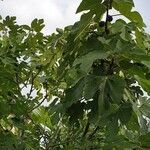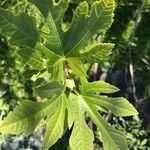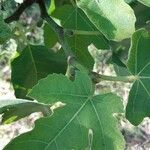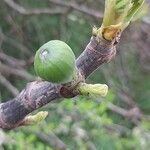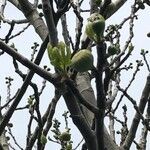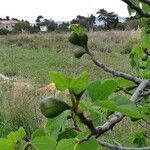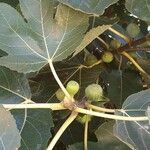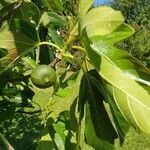A fig. It is a low spreading deciduous tree with large leaves. It can grow to 10 m high. Trees are widely spreading with many branches. It has milky sap. The small branches are straight and strong. The leaves spread out like fingers on a hand with 3 or 5 lobes. The leaves are rough textured on the upper surface and downy underneath. The flowers are of one sex only. There are two sex forms-the caprifig and the fig. The caprifigs are dry and hard and develop 3 times a year. They harbour the fig wasp which itself goes through 3 different stages of its life cycle in these 3 fruit seasons. The "fruit" is a hollow receptacle with an opening at the tip. Inside this the flowers grow and mature. The true fruit develop inside this large receptacle. They are produced either singly or in pairs in the axils of leaves. Fruit colour can vary from black, brown, green and yellow. Wild figs have both male and female flower parts but cultivated figs have no male flower parts and the fruit develop without fertilisation for Adriatic figs but need a fig wasp for Smyrna figs. There are several hundred cultivated kinds of fig.
Shrubs, 3-10 m tall, many branched. Bark grayish brown, distinctly lenticellate. Branchlets straight, strong. Stipules red, ovate-lanceolate, ca. 1 cm. Leaves alternate; petiole strong, 2-5 cm; leaf blade broadly ovate, usually with 3-5 ovate lobes, 10-20 × 10-20 cm, thickly papery, abaxially densely covered with small cystoliths and short gray pubescence, adaxially scabrous, base ± cordate, margin irregularly toothed; basal lateral veins 2-4, secondary veins 5-7 on each side of midvein. Figs axillary on normal leafy shoots, solitary, purplish red to yellow when mature, pear-shaped, large, 3-5 cm in diam., apical pore concave, sessile; involucral bracts ovate. Male flowers: near apical pore; calyx lobes 4 or 5; stamens (1 or)3(-5). Gall flowers: style lateral, short. Female flowers: calyx lobes 4 or 5; ovary ovoid, smooth; style lateral; stigma 2-branched, linear. Achenes lenslike. Fl. and fr. May-Jul.
Shrub or tree to 10 m high, deciduous. Leaves alternate, usually palmately lobed; lamina usually 3–5-lobed (there are cultivars/varieties with various leaf forms), c. 10–20 (–30) cm long and wide (often longer than wide), ± cordate at base, often minutely lobed or toothed on margin (often mainly in the upper parts of the main lobes), paler below, sparsely hairy mainly on veins (lightly scabrid above, tomentose below); petiole to 11 (–15) cm long, hairy; stipules to c. 1 cm long. Figs axillary, solitary, shortly pedicellate, ovoid to pyriform, c. 5–8 cm long, fleshy, green turning reddish or brownish to purple or sometimes almost black at maturity (also yellow forms); ostiole small, covered by bracts. Flowers unisexual; sepals 1–7. Male flowers with a stamen opposite each sepal. See also Messina (2015).
Shrubs or small trees , deciduous, to 5 m. Roots not adventitious. Bark grayish, slightly roughened. Branchlets pubescent. Leaves: stipules 1-1.2 cm; petiole 8-20 cm. Leaf blade obovate, nearly orbiculate, or ovate, palmately 3-5-lobed, 15-30 × 15-30 cm, base cordate, margins undulate or irregularly dentate, apex acute to obtuse; surfaces abaxially and adaxially scabrous-pubescent; basal veins 5 pairs; lateral veins irregularly spaced. Syconia solitary, sessile, green, yellow, or red-purple, pyriform, 5-8 cm, pubescent; peduncle ca. 1 cm; subtending bracts ovate, 1-2 mm; ostiole with 3 subtending bracts, umbonate.
Deciduous, dioecious shrub or small tree up to 10 m high. Young stems ± glabrous to moderately hairy, becoming glabrous. Lvs sparsely to moderately hairy above, often densely hispid below, usually deeply palmately 3-7-lobed and irregularly serrate or crenate, broadly ovate, obtuse to cordate and symmetric at base, c. 10-25 cm long; veins not prominently raised; petiole < blade; stipules 2 per node, glabrous, oblong, caducous. Infl. sparsely hairy, pyriform, green, shortly pedunculate. Syncarp green to purplish, 5-8 cm long; achenes irregularly ovoid to subglobose, c. 2 mm long.
Shrub or small tree. Blade broadly ovate to suborbicular, up to ca. 25 x 20 cm, apex obtuse, 3-5-lobed or-fid, base cordate; secondary veins 6-10 pairs. Figs pedunculate obovate to pyriform to globose, up to 5 cm in diam., becoming brownish-purple or yellowish.
